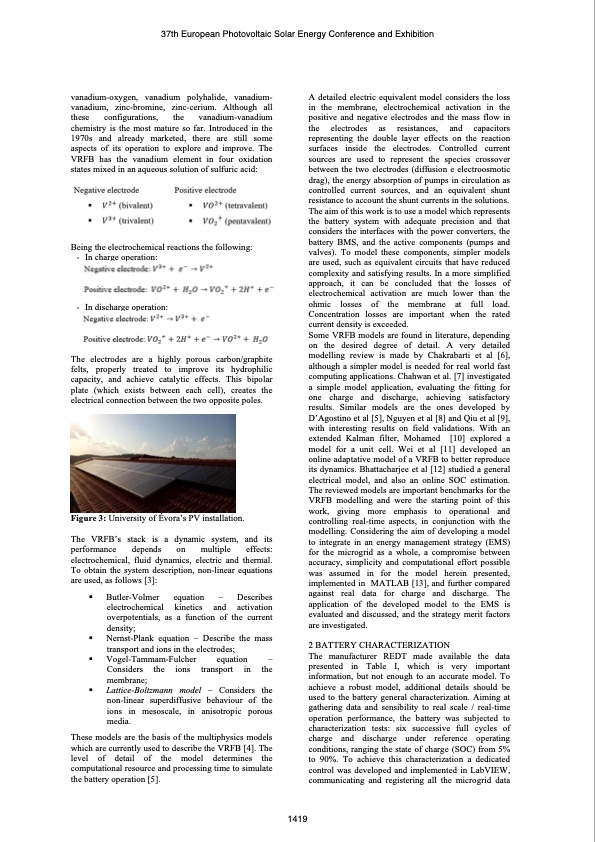
PDF Publication Title:
Text from PDF Page: 002
37th European Photovoltaic Solar Energy Conference and Exhibition vanadium-oxygen, vanadium polyhalide, vanadium- vanadium, zinc-bromine, zinc-cerium. Although all these configurations, the vanadium-vanadium chemistry is the most mature so far. Introduced in the 1970s and already marketed, there are still some aspects of its operation to explore and improve. The VRFB has the vanadium element in four oxidation states mixed in an aqueous solution of sulfuric acid: Being the electrochemical reactions the following: - Inchargeoperation: - Indischargeoperation: The electrodes are a highly porous carbon/graphite felts, properly treated to improve its hydrophilic capacity, and achieve catalytic effects. This bipolar plate (which exists between each cell), creates the electrical connection between the two opposite poles. Figure 3: University of Évora’s PV installation. The VRFB’s stack is a dynamic system, and its performance depends on multiple effects: electrochemical, fluid dynamics, electric and thermal. To obtain the system description, non-linear equations are used, as follows [3]: A detailed electric equivalent model considers the loss in the membrane, electrochemical activation in the positive and negative electrodes and the mass flow in the electrodes as resistances, and capacitors representing the double layer effects on the reaction surfaces inside the electrodes. Controlled current sources are used to represent the species crossover between the two electrodes (diffusion e electroosmotic drag), the energy absorption of pumps in circulation as controlled current sources, and an equivalent shunt resistance to account the shunt currents in the solutions. The aim of this work is to use a model which represents the battery system with adequate precision and that considers the interfaces with the power converters, the battery BMS, and the active components (pumps and valves). To model these components, simpler models are used, such as equivalent circuits that have reduced complexity and satisfying results. In a more simplified approach, it can be concluded that the losses of electrochemical activation are much lower than the ohmic losses of the membrane at full load. Concentration losses are important when the rated current density is exceeded. Some VRFB models are found in literature, depending on the desired degree of detail. A very detailed modelling review is made by Chakrabarti et al [6], although a simpler model is needed for real world fast computing applications. Chahwan et al. [7] investigated a simple model application, evaluating the fitting for one charge and discharge, achieving satisfactory results. Similar models are the ones developed by D’Agostino et al [5], Nguyen et al [8] and Qiu et al [9], with interesting results on field validations. With an extended Kalman filter, Mohamed [10] explored a model for a unit cell. Wei et al [11] developed an online adaptative model of a VRFB to better reproduce its dynamics. Bhattacharjee et al [12] studied a general electrical model, and also an online SOC estimation. The reviewed models are important benchmarks for the VRFB modelling and were the starting point of this work, giving more emphasis to operational and controlling real-time aspects, in conjunction with the modelling. Considering the aim of developing a model to integrate in an energy management strategy (EMS) for the microgrid as a whole, a compromise between accuracy, simplicity and computational effort possible was assumed in for the model herein presented, implemented in MATLAB [13], and further compared against real data for charge and discharge. The application of the developed model to the EMS is evaluated and discussed, and the strategy merit factors are investigated. 2 BATTERY CHARACTERIZATION The manufacturer REDT made available the data presented in Table I, which is very important information, but not enough to an accurate model. To achieve a robust model, additional details should be used to the battery general characterization. Aiming at gathering data and sensibility to real scale / real-time operation performance, the battery was subjected to characterization tests: six successive full cycles of charge and discharge under reference operating conditions, ranging the state of charge (SOC) from 5% to 90%. To achieve this characterization a dedicated control was developed and implemented in LabVIEW, communicating and registering all the microgrid data ▪ Butler-Volmer electrochemical kinetics and activation overpotentials, as a function of the current density; ▪ Nernst-Plank equation – Describe the mass transport and ions in the electrodes; ▪ Vogel-Tammam-Fulcher equation – Considers the ions transport in the membrane; ▪ Lattice-Boltzmann model – Considers the non-linear superdiffusive behaviour of the ions in mesoscale, in anisotropic porous media. These models are the basis of the multiphysics models which are currently used to describe the VRFB [4]. The level of detail of the model determines the computational resource and processing time to simulate the battery operation [5]. equation – Describes 1419PDF Image | VANADIUM REDOX FLOW BATTERY MODELLING

PDF Search Title:
VANADIUM REDOX FLOW BATTERY MODELLINGOriginal File Name Searched:
Vanadium-Redox-Flow-Battery-Modelling.pdfDIY PDF Search: Google It | Yahoo | Bing
Salgenx Redox Flow Battery Technology: Salt water flow battery technology with low cost and great energy density that can be used for power storage and thermal storage. Let us de-risk your production using our license. Our aqueous flow battery is less cost than Tesla Megapack and available faster. Redox flow battery. No membrane needed like with Vanadium, or Bromine. Salgenx flow battery
| CONTACT TEL: 608-238-6001 Email: greg@salgenx.com | RSS | AMP |